Anise hyssop is an aromatic, licorice-flavented herb that can add depth and interest to many culinary dishes. While it’s not a commonly grown herb, anise hyssop is worth getting to know. With its sweet, complex flavor and showy flowers that attract pollinators, anise hyssop can be a valuable addition to an herb garden.
Learning how to properly harvest anise hyssop ensures you get the maximum flavor and yield from each plant. Follow this guide to discover when and how to harvest anise hyssop leaves, flowers, and seeds
When to Harvest Anise Hyssop
Timing is everything when it comes to harvesting herbs. Harvest anise hyssop at the right time to maximize the flavor and aroma of the leaves and flowers.
Leaves
For the best flavor harvest anise hyssop leaves just before the plant flowers. This is when the leaves contain the highest concentration of essential oils. Harvesting leaves frequently through the growing season encourages new growth and a continuous supply of flavorful leaves.
Begin snipping fresh leaves from the plant as soon as it reaches 6 inches tall. Pick leaves from the bottom of the plant first and work your way up as the plant grows taller. Avoid stripping the plant by never removing more than one-third of the leaves at one time.
Flowers
Anise hyssop produces beautiful lavender flower spikes that can be used fresh or dried Harvest flowers when they are half to fully open for peak flavor and color. The bloom period for anise hyssop is mid-summer into fall.
When the stalk’s bottom flowers start to open, cut the flower spikes off as a whole. If you wait until the flowers are fully open, they will go to seed too soon. For continuous bloom, deadhead spent flowers.
Seeds
If you wish to collect anise hyssop seeds, allow a few flower spikes to remain on the plants after bloom. Harvest seeds when the flowers turn brown and the seed heads begin to dry. Seeds can be collected in late summer into fall.
How to Harvest Anise Hyssop
Use proper harvesting techniques to avoid damaging the anise hyssop plant. Here are some tips:
-
Harvest in the early morning after the dew has evaporated for the highest concentration of oils in the leaves.
-
Cut leaves and flowers with gardening shears or pruners. Select healthy, vibrant growth. Avoid battered or insect-damaged leaves.
-
Cut stems back to a leaf node to make room for new growth. Don’t strip leaves off the stems.
-
When harvesting flowers, cut the entire flower spike down to the leaf node.
-
Place cut leaves and flowers in a basket or open container so air can circulate. Avoid crushing the leaves to prevent bruising.
-
To collect seeds, bend dried seed heads into a paper bag and shake to loosen the tiny seeds. Screen out debris like stems and pods.
-
After harvesting, promptly wash and dry the leaves and flowers. Use or preserve them as soon as possible.
-
Record your harvest yields from each plant. This helps plan future harvests and determine ideal planting amounts.
How Much to Harvest
When you harvest anise hyssop, you should always leave at least two-thirds of the leaves on each plant whole. Taking off no more than a third of the leaves at a time keeps the plant from getting stressed.
Here are some guidelines for harvest amounts:
-
2-3 plants: Enough for using fresh and cooking
-
5 plants: Enough for weekly harvests for teas and seasoning
-
10 plants: Provides fresh use plus drying and preserving
Don’t harvest too much until you know how much your plants can produce in your growing conditions. Adjust your harvest amounts accordingly in future seasons.
How to Dry Anise Hyssop
Drying allows you to enjoy the flavor of homegrown anise hyssop year-round. To dry:
-
Select leaves and flowers that are healthy, dry, and clean.
-
Discard any bruised, insect-damaged, or discolored parts.
-
Place the leaves and flowers in a single layer on mesh dehydrator trays.
-
Dehydrate at 95°F until the leaves are brittle and crumble easily. This takes around 4 hours.
-
To air dry leaves, bundle small bunches together and hang upside down in a warm, well-ventilated area out of direct sunlight.
-
Allow 1-2 weeks for air drying. Leaves are done when crumbly and brittle.
-
For flowers, spread the spikes in a single layer on mesh racks or paper. Air dry for 1-2 weeks.
-
Check dried herbs frequently to prevent over drying.
-
Strip leaves and flowers from stems and store in airtight glass jars or resealable plastic bags.
-
Keep jars in a cool, dark place. Properly dried anise hyssop will retain flavor for up to a year.
Freezing Anise Hyssop
Freezing also preserves the flavor and aroma of freshly harvested anise hyssop. To freeze:
-
Select young, healthy leaves and flowers. Wash and pat thoroughly dry.
-
For leaves, remove from stems and tightly pack into freezer containers or bags.
-
For flowers, lay whole flower spikes in a single layer on a sheet pan and place in the freezer until frozen solid. Transfer to freezer bags.
-
Squeeze out excess air, seal, label, and freeze.
-
Frozen anise hyssop leaves maintain flavor for about 6 months. Use frozen flowers within 1 year.
Uses for Harvested Anise Hyssop
The sweet licorice-anise aroma of the leaves and flowers makes anise hyssop a versatile culinary herb.
Culinary Uses
-
Add chopped fresh or dried leaves to salads, sauces, marinades, soups, grain and bean dishes, breads, and more.
-
Use leaves when cooking fish, poultry, pork, and fall fruits and vegetables like squash, carrots, and sweet potatoes.
-
Add snipped fresh leaves and flowers to fruit salads, baked goods, and beverages.
-
Freeze leaves in ice cube trays with water or stock for flavored cubes.
-
Steep dried, crumbled leaves in teas and lemonade.
Crafting Uses
-
Bundle dried flowers and foliage for potpourri, sachets, and wreaths.
-
Add dried leaves and flowers to bath teas, herbal soaks, and cosmetics.
-
Infuse vinegars, honey, and oils with fresh or dried anise hyssop.
No matter how you use it, a homegrown harvest of anise hyssop adds a delightfully unique flavor perfect for the end of summer and into fall. With proper harvesting technique, a few anise hyssop plants can provide abundant leaves, flowers, and seeds for months of enjoyment.
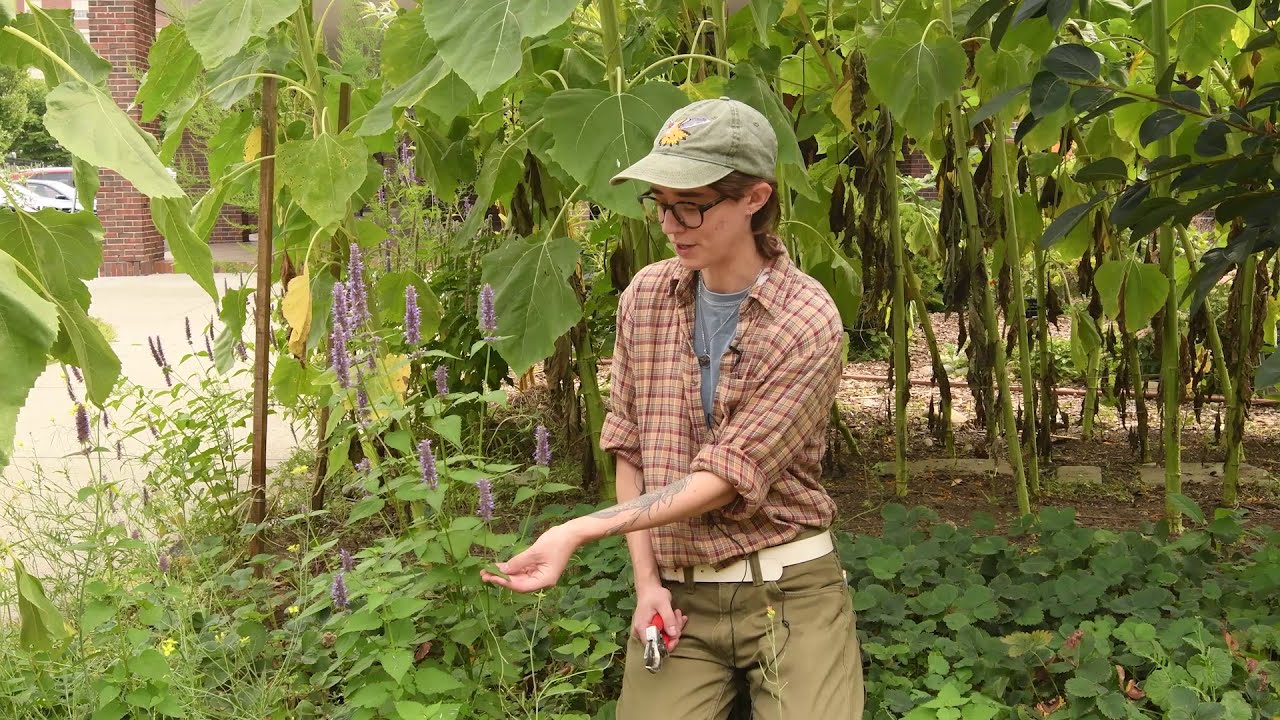
Overview of Anise hyssop
Agastache foeniculum, or anise hyssop, is a short-lived herbaceous perennial plant with blue flowers and fragrant leaves that can be used as a flower or in an herb garden. This plant comes from prairies, dry upland forests, plains, and fields in the upper Midwest and Great Plains into Canada (from northern Colorado to Wisconsin and from Ontario west to British Columbia in Canada). It is hardy in zones 3 to 8. It is in the mint family (Lamiaceae).
Other common names include blue giant hyssop, fragrant giant hyssop and lavender giant hyssop. Despite the common name, it is not closely related to hyssop (Hyssopus spp. ), a European plant traditionally used as a healing herb, or anise, Pimpinella anisum, a completely different plant in the carrot family (Apiaceae).
The upright, clump-forming plants generally grow 2-4 feet tall and about 1-3 feet wide from a small tap root with spreading rhizomes. They have opposite leaves on the square stems (characteristic of the mint plant family). The leaves are dull green, ovate to broad-lanceolate, and up to four inches long. The edges are toothed, and the underside is whitish. The foliage remains nice looking throughout the season and sometimes has a purplish cast on the new growth.
The aromatic leaves have a licorice-like (anise) scent and are used in herbal teas, to flavor jellies or eaten fresh in small quantities, such as in a salad with other greens. The dried leaves can be used in potpourri. The plant was used medicinally by Native Americans. The best time to harvest foliage to dry is when the flowers are just past full bloom, as the oil content in the leaves is the highest at that time, but they can be used at any time.
By midsummer erect terminal cylindrical flower spikes begin to form and continue blooming through fall. The tiny flowers occur in dense, showy verticillasters, or false whorls tightly packed together, that are 3 to 6 inches long. Each tubular flower has two lips like all plants in the mint family, with the lower lip having two small lateral lobes and a larger central lobe and four stamens ending in blue-purple anthers and a cleft style that extend from the flower throat.
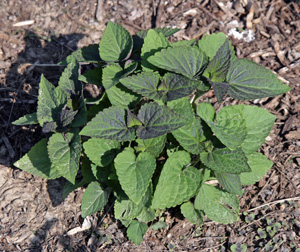
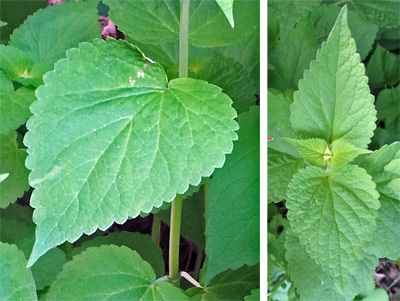

Flower color varies from white to pale blue and lavender through blue-purple, with the color more intense at the tip. The unscented flowers are very attractive to bees – particularly bumblebees, butterflies, beetles and other insects that feed on the nectar or pollen, as well as hummingbirds. Pollinated flowers produce smooth, oval-shaped fruit or seeds that are technically nutlets. Deadhead spent flowers to promote additional bloom. The flower spikes can be cut to use in fresh arrangements or to dry, and the flowers are edible. Plants self-sow readily but undesired seedlings are easy to pull. Goldfinches and other birds may feed on the seeds.
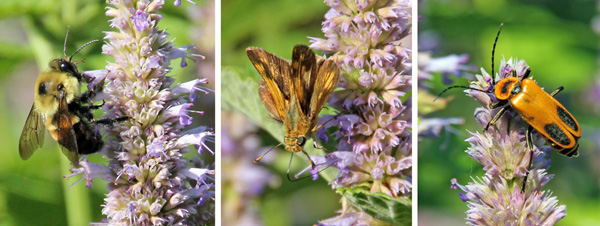
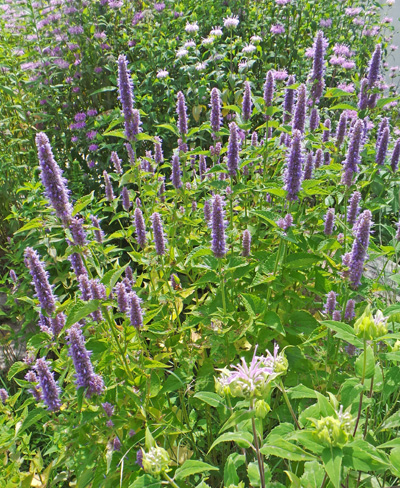
Anise hyssop works well in the middle or back of perennial borders, native or wildflower gardens, cottage gardens, and herb gardens, as well as in meadows and prairies. It can be grown in masses, drifts, or in small clumps. It combines well with other natives such as the biennial brown-eyed Susan (Rudbeckia triloba), goldenrods such as Solidago rugosa ‘Fireworks’, purple coneflower (Echinacea purpurea), bee balm (Monarda spp.), false sunflower (Heliopsis helianthoides) and native grasses. In perennial gardens it mixes well with globe thistle (Echinops ritro), Japanese anemones, Russian sage (Perovskia atriplicifolia), and plants with purple foliage, such as Euphorbia dulcis ‘Chameleon’ or purple-leaved heucheras.
It can also be grown in containers, alone or in combination with other plants. In mixed beds combine it with Verbena bonariensis and various annuals and perennials. The chartreuse foliage of the cultivar ‘Golden Jubilee’ offers good foliar color contrast with other green- or purple-leaved plants.
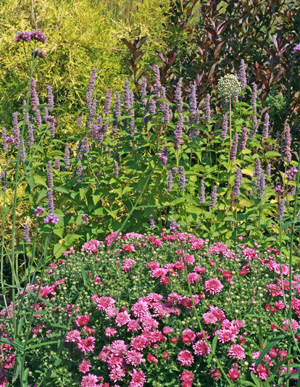
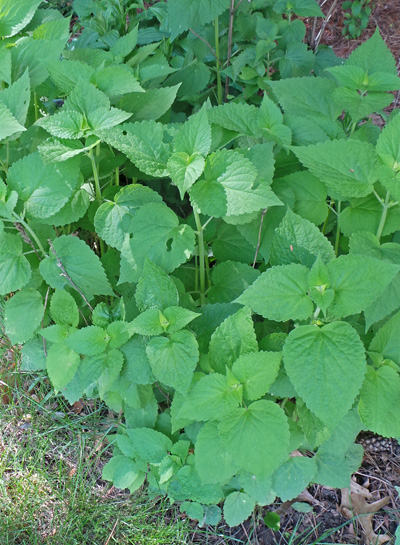

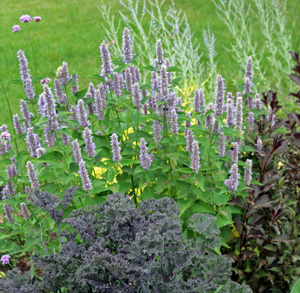
Recommended Anise Hyssop Cultivars
- It has creamy-white flowers on three-foot-tall plants with lighter green leaves that aren’t quite as bushy as the species.
- “Black Adder” is a hybrid plant with dark buds and red-violet flowers. It is not as strong as the species, though.
- ‘Blue Blazes’ – a tall hybrid of A. High Country Gardens brought in Agastache “Desert Sunrise,” which has pinkish calyxes and glowing lavender purple blooms. Hardy to zone 5.
- ‘Blue Fortune’ – a sterile hybrid of A. foeniculum and A. rugosa bred at Arboretum Trompenburg in Rotterdam, Netherlands. It has huge, deep green leaves and very thick spikes of powder blue flowers. The plants get about 3 feet tall and 18 inches wide. It blooms most in the middle of summer and stays flowery for a long time since it doesn’t make seeds. In 2003, the Royal Horticulture Society gave it the Award of Garden Merit.
- “Golden Jubilee” was chosen as an All-American Selection Winner in 2003. It has lime-green to golden-chartreuse leaves that are especially bright yellow in the spring, and its flowers are a normal lavender-blue color. Self-seedlings are mixed with some golden ones.
- “Purple Haze” is a hybrid plant with narrow flower spikes that small native bees are less interested in but still attract a lot of other pollinators.
- “Red Fortune” is a hybrid plant with pink flowers that pollinators don’t like nearly as much as the species.
- There are three-foot plants called “Snow Spike,” which is also called “Album.” They have white flowers.

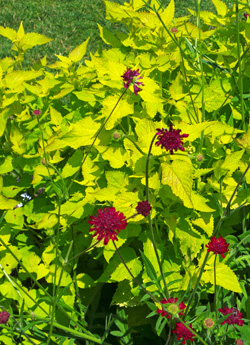

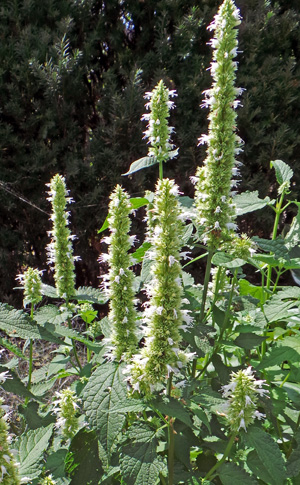
– Susan Mahr, University of Wisconsin—Madison Last Update: Bruce Spangenberg, UW—Madison Extension, 2025
Harvesting Anise Hyssop: When, how, and why.
FAQ
What part of anise hyssop do you use?
The flower spikes can be cut to use in fresh arrangements or to dry, and the flowers are edible. Plants self-sow readily but undesired seedlings are easy to pull. Goldfinches and other birds may feed on the seeds.
How do you harvest and use hyssop?
When harvesting, cut the hyssop plant in the morning once the dew has dried. Then, hang the plant upside down in a dark and well-ventilated area. The leaves of hyssop can be used as an herb or in soups, salads, and other foods.
Can you eat anise hyssop raw?
Anise hyssop has a long history of use. You can use the leaves to season food, dry them and use them in tea, eat them fresh in salads, or candy them.
